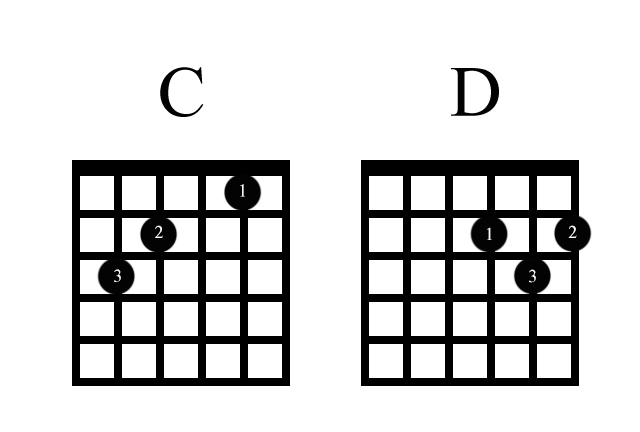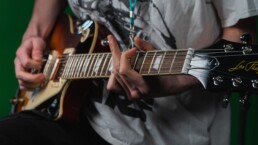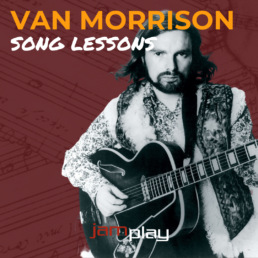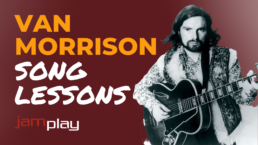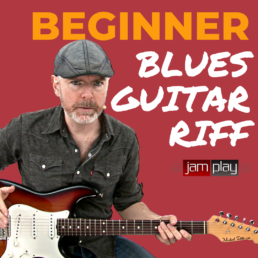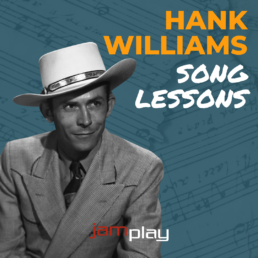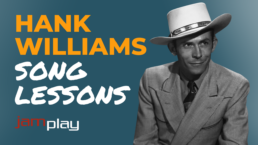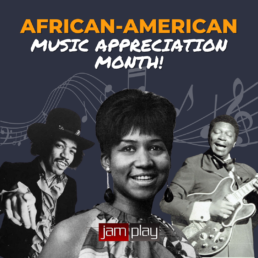Practicing Guitar is Problem Solving

If your practice time doesn’t include some thoughtful problem-solving, you probably aren’t getting as much out of it as you could.
It doesn’t matter if you started playing 40 years ago or yesterday. If you miss a note consistently, it’s a mechanical problem. Every mechanical problem has a mechanical solution.
Notes don’t sound for two basic reasons. The problem is either in the arrival or the departure: the way you land or the way you let go. So we start the process by deciding which it is. Ask yourself the following questions:
-
Which finger is landing on the new note?
-
Which finger held the previous note? Can you prepare or set up the landing?
-
What orientation of the hand brings the finger closest to the target note?
Let’s say you’re working with a transition from an open position C chord to an open position D. These should be familiar:
If you struggle with a chord change like this one, the problem usually has to do with finger placement. Most people are so busy trying to land each finger that they don’t notice their hand.
The standard fingering for a C chord has the ring finger on string 5 and the index on string 2. This usually places the palm more or less level with the bottom of the neck. When we move to the D chord, those two fingers flip their orientation. In the C form, the ring finger is above the index. The D chord fingering is the reverse: index above middle and ring.
Rotating the entire hand and arm carries the fingers into position. The arm movement does most of the work so that the fingers end up more or less hovering over their assigned notes. Now it’s much easier to land accurately, because you aren’t working nearly as hard to get there.
This approach condenses three movements into one. Instead of thinking of three fingers, think of the two shapes and the arm flip that connects them. If both chords don’t ring clearly, the issue is either in how you release the C or land on the D.
We don’t lift our fingers off the strings, we release them.
If we’re proceeding with the premise that the arm does most of the work, it would make sense to say the fingers just need to let go. But the fingers will often carry residual tension, especially if you tend to “grip” your chords. This tension makes it harder to control the fingers effectively and make a clean landing on the target note.
To practice a longer chord sequence or lick, repeat this process, first with the note that follows the problem spot and then the one that precedes it. Gradually add more notes on either side until you can play the entire passage smoothly.
It’s a slow process, so give it time. Most importantly, SLOW DOWN. You need to move slowly enough that you can really control your hands. Once muscle memory is engaged it’s basically impossible to get ahead of. So we need to bypass any established muscle memory and replace it with a more detailed and controlled model.
Playing out of time like this, the song won’t sound much like it’s supposed to.
But that’s not the point right now. Our goal at the moment is not to play the song but to create an exercise out of it. Once we’ve looked more closely at the movements, we can perform them more accurately in time.
This might be a new way of thinking for you. We’re very accustomed to hearing how repetition is important, and that IS true. But blind repetition won’t get you anywhere, so learn to slow down and pay closer attention!
Remember that effective practicing is a process. It’s possible to learn a song by just starting at the first note, playing to the last note, and doing it again. But before long, it becomes clear that some things are easier than others. So we need to concentrate more on those things, and also work to integrate them smoothly. It’s simple problem solving, and an important part of the process of learning to play.
Did you know JamPlay and TrueFire merged their video lesson libraries to form the industry’s most comprehensive guitar learning platform? Learn more by clicking HERE and check out the 70,000+ video guitar lessons on TrueFire.
Dave Isaacs has established himself as a guitar teacher extraordinaire, having built a strong set of educational curriculums for beginner, intermediate, and advanced guitar players alike. Dave shares his expertise largely through video platforms, but also through his thoughtful writing. You can take guitar lessons from Dave Isaacs via his comprehensive video guitar courses on TrueFire.com.
Share this
Become a JamPlay member for unlimited access to 7000+ guitar lessons and 120+ artists and instructors. View membership plans ›
Related Posts
September 2, 2023
Great Guitar Playing is Dynamic

What makes the difference between a competent player and a great one?
Imagine two skilled guitar players trading solos onstage playing identical Les Pauls through identical Marshalls. One is clearly skilled and hits all the right notes at the right time. The other displays the same technical ability, but somehow their playing has more presence and power. What makes the difference?
“Great” playing is well-executed and sonically compelling.
Keith Richards is no virtuoso, but his playing is unquestionably both those things. You know Keef when you hear him, in the same way you might recognize blues legend B.B. King. Pink Floyd’s David Gilmour is revered for his melodic phrasing and tone.

Jeff Beck is often described as the best electric guitar player of all time. Jimi Hendrix and Eddie Van Halen are also strong candidates for the GOAT. But chops alone did not define their playing, their musical personality did. All three are instantly recognizable when you hear them. And all three have something important in common: their playing was highly dynamic.

“Dynamics” in music has to do with volume and intensity.
When “Smells Like Teen Spirit” burst onto the radio airwaves, one of the things that made Nirvana sound so fresh was the abrupt dynamic contrasts between the different sections of the song. The “very loud to very soft” shifts were a big part of their style.

These kinds of contrasts draw the listener’s ear. Imagine your most boring college professor droning in a monotone, and compare that with your memory of a stirring speaker. Dynamics are essential, because uniform sounds don’t really exist in the natural world. Have you ever sat outside on a summer night listening to the sound of cicadas in the trees? It can blend together into a single whir, but it’s also a conversation.
Even the sound of a mechanical device can be dynamic: listen to the hum of an air conditioner or a car motor. The dynamic effect comes from many subtle variations in the sound. Even “static” is not actually static: the sound is very much in motion.
Great playing applies dynamics on every level, not just between sections of a song.
A strong melody is made even stronger when it’s played dynamically. That means the notes aren’t uniform in volume, but vary according to the player’s articulation and the “shape” of the melody.
Try this simple exercise. Here are two ways to play a C major scale:
Start very softly and play a gradual crescendo as you go up (getting louder with each note). Do the opposite coming down. Then do the same with the alternate fingering. Be sure to start softly so you have room to make the contrast dramatic and obvious. Notice how differently the strings respond in the different positions.
Now play the following figure:
There are lots of ways you could “shape” the dynamic of this line:
- Steady crescendo
- Steady diminuendo
- Dynamic “swells” on each bar
- Dynamic swells on each 4-note group
- Accent the first note of each group of four
- Accent the third note of each group
Things get really interesting when these accents start to reveal internal rhythm groups. For example, accenting the first and fourth notes of each group creates the illusion of a separate bass line:
Articulation is also part of dynamics.
Slides, slurs, bends, and vibrato add variation and different accents as well. This is possibly the most definitive part of a player’s sound: not just the notes they choose, but the way they “shape” them. Instead of just letting the notes ring, you can give each one its own shape or dynamic quality.
Watch Jeff Beck’s performance of the operatic aria “Nessun Dorma” for a masterclass on dynamic touch.
Did you know JamPlay and TrueFire merged their video lesson libraries to form the industry’s most comprehensive guitar learning platform? Learn more by clicking HERE and check out the 70,000+ video guitar lessons on TrueFire.
Dave Isaacs has established himself as a guitar teacher extraordinaire, having built a strong set of educational curriculums for beginner, intermediate, and advanced guitar players alike. Dave shares his expertise largely through video platforms, but also through his thoughtful writing. You can take guitar lessons from Dave Isaacs via his comprehensive video guitar courses on TrueFire.com.
Share this
Become a JamPlay member for unlimited access to 7000+ guitar lessons and 120+ artists and instructors. View membership plans ›
Related Posts
August 30, 2023
Guitar Exercises: Are They Boring, Tedious, Endless?
Half of my social media feed is ads promising relief from “boring, tedious guitar exercises”.
I’ll be frank and use equally strong words: this is a thoughtless perspective. If you find ANY of your guitar exercises “boring” or “tedious”, I have news for you. You’re not accomplishing anything. Maybe you already know this, or you’re aware of your lack of real progress.
It’s not that life is too short to be bored practicing guitar, although I’ve heard this expressed by some students.
If you’re “bored”, your execution, tone, and fluidity had better be flawless.
I don’t know about you, but after 40-plus years of playing, I haven’t reached that point yet. And I’ve been a professional musician for 30-plus of those forty years.
Perhaps it’s the emphasis on guitar gymnastics or just the mistaken idea that only “hard” things are hard. The internet guitar universe is full of flashy clickbait that gets attention but delivers little. Blanket indictments are unfair, of course, but let’s face it, it’s hard to cut through the noise and find where the real value is. Of course, this is the great advantage of curated platforms like JamPlay.
With that said, you still need to approach your practice with the right mindset. So let’s address the loaded words in my admittedly clickbait-y title.
1. Boring
If you’re bored, you aren’t paying attention.
Think of the details that go into executing anything well. There’s the obvious accuracy part, landing your fingers in the right place. There is the sound of the resulting notes. There’s the overall picture of maintaining relaxed flow and concentration. And then, if we’re talking exercises, of course there’s speed.
I don’t think it’s going too far out on a limb to suggest that you could ALWAYS be more accurate and confident. The “confidence” part of this is important. You might know the notes, but can you nail them every time? Are you in control of your hands or is there an element of uncertainty and hope when you start down that black diamond run?
If you can’t find any element of a particular exercise or passage that could use improvement, congratulations! Pat yourself on the back and move on to the next. But in my experience, there’s nearly ALWAYS something you could do better.
2. Tedious
This might just be a synonym for “boring”. Let’s say the tedium is repetition without new information.
So, IS there any new information? As mentioned above, is there anything you observe regarding your execution or tone? Is there a buzzy note that stubbornly won’t ring clearly? A shift that’s a little uncertain? Muddiness or sloppiness in your picking? Do you need a compressor in order to play a scale with consistent tone? These are all questions you can ask yourself.
Great players are in command of their touch first and foremost.
The purpose of exercises is to practice your touch, and to recognize how different finger patterns make different demands on the hands. Are you aware of any tension, or worse, pain or strain? These are signals that demand your attention, but too many students accept them because “it’s supposed to be hard”.
Well, yes, it is, but it’s not supposed to be painful, physically or mentally.
“Tedious” exercises are meant to be divorced from their musical context so you can concentrate on pure mechanics. Even a passage from a song can be broken down to a finger exercise that will help you play the song better. But you need to treat that passage as an exercise and not be thrown off because it “doesn’t sound like the song” anymore. Out of context and slowed down, it won’t! But isolating a specific movement or sound lets you focus purely on its execution. THEN we work to increase the speed and integrate that movement into the flow of the song.
3. Endless
I hate to break it to you, but this one is accurate. It IS endless. But that’s part of the beauty, isn’t it. I can’t play everything I want to play as well as I would like, but it’s not because of a technical deficit. It’s because there is so much to know, and always something new to absorb. If this weren’t the case, then Hendrix, Van Halen, Malmsteen and Vai wouldn’t have had the impact they had. These players broke new ground and showed us something more was possible. They took their influences and foundations and elevated them to the stratosphere. (No pun intended, but it does apply, doesn’t it?)
Dropping the names above does sound like proof one can fully “master” the guitar, and mastery is clearly on display in their music. But I believe any one of them would agree with my main point here. Even at the dizzying heights of skill these players attained, it’s unlikely any of them would have said they were finished learning and improving.
Don’t believe the hype. There’s no “one weird trick” or “secret that guitar teachers won’t show you”.
There is only you, your guitar, your mindset, and the music. So don’t be bored. Pay attention and be amazed by how much you find.
Did you know JamPlay and TrueFire merged their video lesson libraries to form the industry’s most comprehensive guitar learning platform? Learn more by clicking HERE and check out the 70,000+ video guitar lessons on TrueFire.
Dave Isaacs has established himself as a guitar teacher extraordinaire, having built a strong set of educational curriculums for beginner, intermediate, and advanced guitar players alike. Dave shares his expertise largely through video platforms, but also through his thoughtful writing. You can take guitar lessons from Dave Isaacs via his comprehensive video guitar courses on TrueFire.com.
Share this
Become a JamPlay member for unlimited access to 7000+ guitar lessons and 120+ artists and instructors. View membership plans ›
Related Posts
July 31, 2023
Van Morrison Song Lesson Playlist
In the world of “classic rock” music, few names resonate with such enduring influence and poetic brilliance as Van Morrison. His musical journey began as a young boy, when he first discovered his love for music, inspired by his father’s vast record collection. As a teenager, he joined several bands and honed his craft, mastering various instruments, including the guitar, harmonica, and saxophone. His unique blend of soul, R&B, folk, jazz, and blues set him apart, earning him the nickname “The Belfast Cowboy.”
Morrison’s early career saw him achieve fame as the lead vocalist for the band Them, known for their chart-topping hit “Gloria.” However, it was his solo career that propelled him to stardom, unveiling a soulful, mystical sound that left audiences captivated.
In this blog, we’ll be coving some of the Van Morrison songs you can learn on guitar using JamPlay and TrueFire’s intuitive learning tools. Grab your guitar and let’s play some hits!
“Into The Mystic” – Van Morrison Song Lesson – JamPlay
Recorded in 1969 and released on Van Morrison’s 1970 LP, Moondance, “Into The Mystic” is hailed a masterpiece of songcraft. The song is often compared to other great works like The Beatles’ “Yesterday” and Van Morrison’s greatest hit, “Brown Eyed Girl.” Rolling Stone named this track on its master list of The 500 Greatest Songs of All Time.
In this lesson, Jeffery Marshall teaches you how to play “Into The Mystic” note-for-note on the guitar. For the full lesson with tab & notation, check out Jeffery’s course on TrueFire!
“Wild Night” – Van Morrison Song Lesson – JamPlay
The opening track on Van’s fifth studio album, Tupelo Honey, “Wild Night” climbed to No. 28 on the Billboard Hot 100 when it was released as a single in 1971. Then in 1994, a cover version by John Mellencamp and Meshell Ndegeocello peaked at No. 3 on he Hot 100. Needless to say, this timeless hit is worth covering if it piques your interest!
Follow along with John Auker as he shows you how to play “Wild Night” on guitar note-for-note. Get the breakdown of each part in John’s full lesson on TrueFire!
Did you know JamPlay and TrueFire merged their video lesson libraries to form the industry’s most comprehensive guitar learning platform? Learn more by clicking HERE and check out the 70,000+ video guitar lessons on TrueFire.
Share this
Become a JamPlay member for unlimited access to 7000+ guitar lessons and 120+ artists and instructors. View membership plans ›
Related Posts
July 20, 2023
One Service to Unite Them All!
JamPlay & TrueFire Have Combined Forces to Enrich and Expand Your JamPlay Membership With More Lessons, Educators, and So Much More!
We’ve got exciting news! Today JamPlay officially merges our legendary content library with TrueFire’s to form the most comprehensive online guitar learning platform on the PLANET! This union will elevate your guitar and bass learning experience by combining the very best elements of both services to deliver the JamPlay experience that you’ve come to expect PLUS unlimited access to the full lineup of TrueFire’s extensive lesson library and revolutionary learning tools - all in one convenient and awesome service!
As one of our loyal JamPlay Members, you will now have access to a mind-boggling:
- 70,000+ online lessons
- 400+ world-class educators
- Industry-leading learning tools
- Cutting-edge desktop, mobile, and OTT apps
We know right now you’re thinking, “What’s this gonna cost me?”
Well…we’re happy to say that this massive upgrade comes at no additional cost to you!
Look, we know that this is a big change. Whether you’ve been with us since way back in 2007 or you’re a new member that has just joined the community - rest assured your existing JamPlay membership will be transitioned seamlessly. Our newly expanded team of guitar junkies, gearheads, and theory-nuts will be here to help with any questions or concerns that you may have about the move. Same as it ever was - we’re in this together!
You can click HERE for the full FAQ or log in now with your JamPlay account to gain immediate access to all of your new lessons, tools, and toys!
To learn more about the JamPlay / TrueFire merger, click HERE.
With excitement and gratitude -
Sincerely,
Your JamPlay Team
Learn This Beginner Blues Guitar Riff
The blues and boogie-woogie are both popular musical styles that originated in the African American communities of the United States in the late 19th and early 20th centuries. Though popular in their original forms, these styles eventually played huge roles in the development of various genres of music, particularly jazz and rock ‘n’ roll. And, in turn, these movements birthed some of the most iconic blues and rock guitar riffs. Follow along with guitarist and educator, Jeff McErlain as he walks you through learning a variation of blues’ most recognizable guitar riff.
A Blues Guitar Riff To Get You Started!
What is a 12-bar blues?
The 12-bar blues is a specific chord progression that forms the foundation for countless blues songs. It consists of three four-bar segments, and each segment follows a specific chord pattern. The basic structure is as follows:
- The first four bars (often referred to as the “first line”) typically use the I chord (the “tonic” or root chord of the key). For example, if the song is in the key of A, the I chord would be A.
- The next two bars (the “second line”) move to the IV chord (the subdominant). In the key of A, the IV chord would be D.
- The next two bars (the “third line”) return to the I chord.
- The final four bars (the “fourth line”) use the V chord (the dominant). In the key of A, the V chord would be E.
We use roman numerals to represent this progression. Those roman numerals typically look like this: I-IV-I-V-IV-I, indicating the chord sequence. The 12-bar blues structure provides a framework for improvisation, allowing musicians to express their own style while staying within a recognizable form.
What is boogie-woogie?
Boogie-woogie, on the other hand, is a piano-based style characterized by a strong, repetitive bass pattern and syncopated melodies. It emerged in the early 20th century and was known for its energetic qualities. While boogie-woogie is primarily associated with piano, it didn’t take long for it to extend to guitar playing as well.
In boogie-woogie guitar riffs, the guitarist usually adapts the piano bass line to the guitar’s lower strings. They often use a combination of palm muting, slides, and rhythmic patterns to mimic the piano’s rhythmic drive. The right hand employs a technique called “strumming in triplets,” emphasizing the swing feel that defines boogie-woogie. Though boogie-woogie guitar riffs can vary in complexity, they always involve a strong emphasis on rhythm and groove.
For more Jeff McErlain guitar lessons and a massive library of Song Lessons, check out JamPlay.com! JamPlay has over 450 guitar courses from 120+ instructors, and online guitar lessons tailored to every skill level, music genre, and playing style. Click here to learn more.
Share this
Become a JamPlay member for unlimited access to 7000+ guitar lessons and 120+ artists and instructors. View membership plans ›
Related Posts
July 11, 2023
Eve 6 Song Lesson Playlist
Californian alternative rock band, Eve 6, got an early start in the music industry. The band, which formed in 1995 under the name “Eleventeen” signed a record deal while all of the members were still high schoolers. Despite their young ages, the band didn’t take long to top the charts; in 1998 the band scored their first platinum, chart-topping success. Before the band’s first hiatus (2004), Eve 6 appeared on several high-profile talk shows, including The Tonight Show with Jay Leno, Jimmy Kimmel Live!, and even The Late Show with David Letterman.
In this blog, we’ll be highlighting some of the Eve 6 smash hits you can learn on guitar with JamPlay’s top educators and learning tools. Grab your guitar, and let’s learn some songs!
“At Least We’re Dreaming” – Eve 6 Song Lesson – JamPlay
From their “experimental” LP, “At Least We’re Dreaming” reveals a more somber side of Eve 6. Though, this isn’t reflected in the instrumentation. As you learn the song, you’ll find yourself playing many different upbeat guitar parts!
Follow along with Chris Liepe as he details how to play all of the guitar parts for “At Least We’re Dreaming.” You can find the full lesson with tab & notation on JamPlay!
“Here’s To The Night” – Eve 6 Song Lesson – JamPlay
From Eve 6’s sophomore album, Horrorscope, “Here’s To The Night” is one of the band’s greatest hits. Once a favorite at high school graduation ceremonies and parties, this rock hit peaked at No. 30 on Billboard’s Hot 100 charts – a stunning feat for such a young band.
In this lesson, Chris Liepe shows you how to play all of the guitar parts for “Here’s To The Night” note-for-note. Jump into the full lesson with tab on JamPlay!
“Inside Out” – Eve 6 Song Lesson – JamPlay
Remember when we said Eve 6 had crazy, platinum-selling success early on? It’s mostly thanks to “Inside Out,” which is considered to be the band’s biggest hit. Debuting as the first single from their first, self-titled album, “Inside Out” spent a total of four weeks at No. 1 across several US rock charts.
Grab your guitar and learn this smash rock hit with Chris Liepe. For the full lesson with tab & notation, check out Chris’ course on JamPlay!
For more Song Lessons, check out JamPlay.com! JamPlay has over 450 guitar courses from 120+ instructors, and online guitar lessons tailored to every skill level, music genre, and playing style. Click here to learn more.
Share this
Become a JamPlay member for unlimited access to 7000+ guitar lessons and 120+ artists and instructors. View membership plans ›
Related Posts
July 7, 2023
Hank Williams Song Lesson Playlist
When examining the history of any musical genre, we often first point out the influential figures that ushered it into popularity. Hank Williams Sr. is doubtlessly one such figure. Hiram King Williams, born on September 17, 1923, became an iconic player in the realm of American music and changed the country music landscape forever. His timeless songs and distinctive style continue to resonate with fans and inspire countless musicians. Throughout his tragically short career, Williams managed to revolutionize country music. This would eventually lead to him posthumously being awarded some of the highest accolades a musician can achieve. Namely, Hank Williams was awarded a GRAMMY Lifetime Achievement Award, and a GRAMMY Award for Grammy for Best Country Vocal Collaboration on “There’s a Tear in My Beer” with Hank Williams, Junior. Hank, Sr. was also awarded a Pulitzer Prize for his role in pioneering country music songcraft.
Needless to say, Hank Williams knew how to write one heck of a song. So, why not try and learn some of his best work yourself? Keep reading for some of the Hank Williams, Sr. song lessons we have to offer here at JamPlay!
“Hey Good Lookin'” – Hank Williams Song Lesson – JamPlay
An inductee to the GRAMMY Hall of Fame, Hank Williams’ “Hey Good Lookin’” is a timeless classic country tune that you’ve probably heard before. Aside from Williams’ topping the Hot Country Singles chart in 1951, the song was covered by a number of notable singers such as Jimmy Buffett, Alan Jackson, George Straight, and Kenny Chesney. Country Music Television even ranked “Hey good Lookin'” No. 19 on its list of 100 Greatest Songs of Country Music.
Follow along with D.J. Phillips as he shows you how to play all of the guitar parts for this classic country hit. For the full lesson, check out his course on JamPlay!
“Your Cheatin’ Heart” – Song Lesson – JamPlay
One of country music’s key standards, “Your Cheatin’ Heart” was originally released posthumously following Hank Williams’ untimely passing. Legend has it that Williams came up with the lyrics to this solemn tune while driving with his then-wife, Billie Jean Jones (though the song was about his ex wife, Audrey Sheppard).
In this lesson, D.J. Phillips demonstrates how to play all of the guitar parts for “Your Cheatin’ Heart.” For the full lesson with tab & notation, check out D.J.’s course on JamPlay!
For more Song Lessons, check out JamPlay.com! JamPlay has over 450 guitar courses from 120+ instructors, and online guitar lessons tailored to every skill level, music genre, and playing style. Click here to learn more.
Share this
Become a JamPlay member for unlimited access to 7000+ guitar lessons and 120+ artists and instructors. View membership plans ›
Related Posts
June 29, 2023
Godsmack Bass Guitar Song Lesson Playlist
When it comes to powerhouse bands that have left a mark on rock music, Godsmack is a name that stands tall. With their raw energy, hard-hitting sound, and captivating performances, it’s no wonder the band has made a name for themselves. Since their inception in 1995, Godsmack has consistently pushed the boundaries of rock music, and have received the accolades to prove it. Not only were they crowned Rock Artist of the Year in 2001 by Billboard, but they were also nominated for two GRAMMY Awards in 2001 and 2006.
In this blog, we’ll be exploring some of the Godsmack songs you can learn on the bass guitar with JamPlay’s intuitive learning tools. Lucky for us at JamPlay, we partnered up with Godsmack bass player, Robbie Merrill to teach us how to play these songs note-for-note. Let’s dive right in!
“Awake” – Godsmack Song Lesson – JamPlay
Peaking at No. 1 on both Billboard’s Mainstream Rock Tracks and Bubbling Under Hot 100 Singles, “Awake” is the first single from Godsmack’s 2000 album by the same name. One interesting fact about this track is that it was featured in 2000’s U.S. Navy recruiting ads that were voiced over by the actor, Keith David.
If you know how the song sound, you may have noticed the tuning sounds quite low. And, you’d be correct! Robbie Merrill is quoted saying his bass is tuned to a special drop C tuning. So, in order to play this, you’ll need to tune your bass’ bottom four strings to C, G, C, and G in descending order. Follow along with this demonstration by Godsmack bassist, Robbie Merrill, as he plays bass on the song, “Awake” in its entirety. For the full breakdown of the lesson, check out Robbie’s course on JamPlay!
“Keep Away” – Song Lesson – JamPlay
Godsmack’s 1999 single, “Keep Away” brought the band some preliminary recognition; it got them some of their most significant early radio airtime. It eventually peaked at No. 5 on Billboard’s Mainstream Rock Tracks and No. 31 on the Modern Rock Tracks chart.
In order to follow along with this bass guitar lesson for “Keep Away,” you’ll need to tune your bass to drop D. So, your bottom four strings should be tuned to D, A, D, and G in descending order. For the full lesson and breakdown from Robbie Merrill, check out his full course on JamPlay.
“Voodoo” – Godsmack Song Lesson – JamPlay
A theme song for the WWE wrestler and actor, Dave Bautista, “Voodoo” is an interesting track to say the least. Although released as a single, the album version of the song runs for over nine minutes. This is because, after the first four minutes and forty seconds, there are about two minutes of total silence before a hidden track entitled, “Witch Hunt” can be heard. The single version of this song was also featured in the MTV show, Fear.
This song is also played in drop D. Follow along with Godsmack bassist, Robbie Merrill as he demonstrates how to play “Voodoo” note-for-note on the bass. Get the full lesson with tab & notation on JamPlay.
For more Song Lessons, check out JamPlay.com! JamPlay has over 450 guitar courses from 120+ instructors, and online guitar lessons tailored to every skill level, music genre, and playing style. Click here to learn more.
Share this
Become a JamPlay member for unlimited access to 7000+ guitar lessons and 120+ artists and instructors. View membership plans ›
Related Posts
June 23, 2023
Happy African-American Music Appreciation Month!
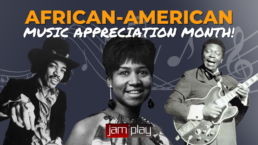
June is an exciting month for music enthusiasts and cultural appreciators alike, as it is recognized as African-American Music Appreciation Month in the United States. This annual observance provides an opportunity to celebrate and honor the immense contributions of African-Americans to the vibrant tapestry of American music. From soul-stirring spirituals to foot-tapping jazz, and from timeless R&B songs to infectious hip-hop beats, African-American music has had arguably the most potent influence on the modern music industry.
Here at JamPlay, we are especially celebratory of guitar music. And, there are a lot of legendary African-American guitar players to celebrate throughout U.S. history! In this blog, we’ll cover just some of the most notable guitar players and musicians who you can celebrate this month. We’ll even give you some free guitar lessons to help you get in the spirit! Let’s dive right in.
Origins of African American Music Appreciation Month
African-American Music Appreciation Month, also known as Black Music Month, traces its roots back to 1979. It was proposed by President Jimmy Carter, who proclaimed June as “Black Music Month” to recognize the rich and diverse musical traditions of African-Americans. Through the present day, this cultural celebration is honored with concerts and performances, educational programs, museum exhibitions, and even radio tributes. But today, we’re focusing on some of the world’s greatest performers – the people who helped write chapters in the history of black music.
Notable Figures in African-American Music
African-American music boasts a plethora of incredibly talented artists who have inspired generations of musicians. Here, we’ll highlight just a handful of the most notable figures. These are the authors of some of the greatest chapters of African-American music history. And, if you came here to play guitar, we’ll also include lessons for songs and guitar licks made famous by black musicians:
1. Aretha Franklin
Now, I know what you’re thinking… Aretha didn’t play guitar! But, she was a black female icon whose contributions to R&B are undeniable (and we happen to have a guitar lesson featuring one of her greatest hits)! Aretha Franklin, known as the “Queen of Soul,” possessed an unmatched vocal prowess and an ability to convey deep emotions through her music. With hits like “Respect” and “Natural Woman,” Franklin became an epochal figure in music. Let’s look at how to play another great hit of hers.
One of Aretha’s greatest hits was her rendition of “I Say A Little Prayer,” the original writers of which were Burt Bacharach and Hal David. It was also originally recorded by R&B singer, Dionne Warwick and released in 1967. This originally release was hugely successful, and the track peaked at No. 4 on Billboard’s Hot 100. However, it was Aretha’s reinvention of the track that solidified the song as a timeless hit. Her version was eventually listed as No. 117 on Rolling Stone Magazine’s list ofTop 500 Greatest Songs of All Time. Follow along with Callum Bair as he demonstrates a fingerstyle arrangement of “I Say A Little Prayer” on guitar. Get the tab, notation, and lesson breakdown on JamPlay!
2. BB King
One of the Three Kings of the Blues, B.B. King was a force to be reckoned with. A young Riley B. King learned how to play his first three chords from a reverend at his local church. He would then take his skill to the next level under the mentorship of legendary Delta Blues guitarist, Bukka White. Over the course of his playing career, B.B. King developed a distinctive and expressive playing style that became the inspiration for generations of blues guitarists to come. He was nominated for 30 GRAMMY Awards, and won a staggering 15 of them. He was also one of the most prolific guitar players to ever live, usually performing at over 200 concerts per year.
Looking for a taste of B.B. King’s style in your own playing? Adding these two B.B. King guitar licks to your repertoire is a great way to celebrate African-American Music Appreciation Month! Follow along with D.J. Phillips as he breaks down the lick step-by-step. Check out D.J.’s other courses and lessons on JamPlay.
3. Michael Jackson
Michael Jackson, originally part of the Jackson 5, was dubbed the “King of Pop” for a good reason. He captivated the world with his electrifying performances and mesmerizing dance moves. Not to mention, Michael won 13 GRAMMY Awards with chart-topping hits like “We Are The World,” “Beat It, and “Billie Jean.” His influence extended far beyond music, making him a global cultural icon.
Speaking of iconic hits, this video features a clip from Callum Bair’s lesson on his solo guitar arrangement for “Human Nature” by Michael Jackson. Originally written by founding Toto member, Steve Porcaro, the whole song was performed and recorded by Michael Jackson and Toto. The track was produced by Quincy Jones, and was released as the fifth single from Michael’s Thriller album. “Human Nature” would go on to appear in charts globally, and peaked at No. 89 on Billboard’s Hot 100. The song was also certified Platinum in the United States. Learn the whole arrangement with tab & notation on JamPlay!
4. Albert King
Technically the first born of the Three Kings of the Blues (none of whom are related), Albert King made an immeasurable impact on guitar history. What truly set Albert King apart was his innovative use of the electric guitar. He employed thick, heavy strings, often tuned to an open E or open F sharp, and played with a distinctive vibrato and bending style. King’s emotive and soulful playing, combined with his powerful voice, allowed him to convey a depth of emotion that resonated with audiences. Albert was nominated for two GRAMMY Awards during his lifetime. Naturally, he was also inducted into both the Rock & Roll Hall of Fame and the Blues Hall of Fame.
Looking to add some expressive pizzaz to your guitar soloing? Celebrate African-American Music Appreciation Month by taking a page from Albert King’s book. Dive into this Albert King guitar lick lesson, where D.J. Phillips breaks down a famous lick you can use in all kinds of soloing scenarios. For more D.J. Phillips guitar lessons, click here!
5. Jimi Hendrix
Here to finish off this brief list of African-American music legends is a true guitar pioneer. Jimi Hendrix will never be overrated because of the sheer breadth of his influence on guitar players to this day. Jimi was well-known for his masterful use of amplifier feedback, effects pedals, and his unique playing style (an honorable mention goes to Jimi restringing a right-handed guitar upside-down to suit his left-handed playing)! Hendrix pushed the instrument to its limits and beyond, and is rightfully revered because of it.
In this lesson from Brendan Burns, you learn not one… not two… but five Jimi Hendrix guitar licks. These licks ultimately become tools you can use when jamming, writing, or even just practicing. Not to mention, they can always be altered or combined with other licks like those from B.B. or Albert King. For the full course on how to play like Jimi Hendrix, click here!
Embracing the Melodies of African-American Music
As we wrap this article up, what did you learn? African American Music Appreciation Month stands as a testament to the immeasurable contributions of African-Americans to the world of music. This is something all of us could learn more about.
It encourages people from all walks of life to explore, appreciate, and celebrate the incredible cultural heritage and artistic achievements of black musicians. So, this June, let’s immerse ourselves in the melodies, rhythms, and narratives woven by African American artists and recognize the profound impact they have had on the global music scene. Together, let us honor and appreciate their enduring musical legacy.
For more guitar lessons and an ever-growing library of Song Lessons, check out JamPlay.com! JamPlay has over 450 guitar courses from 120+ instructors, and online guitar lessons tailored to every skill level, music genre, and playing style. Click here to learn more.
Share this
Become a JamPlay member for unlimited access to 7000+ guitar lessons and 120+ artists and instructors. View membership plans ›
Related Posts
June 16, 2023


